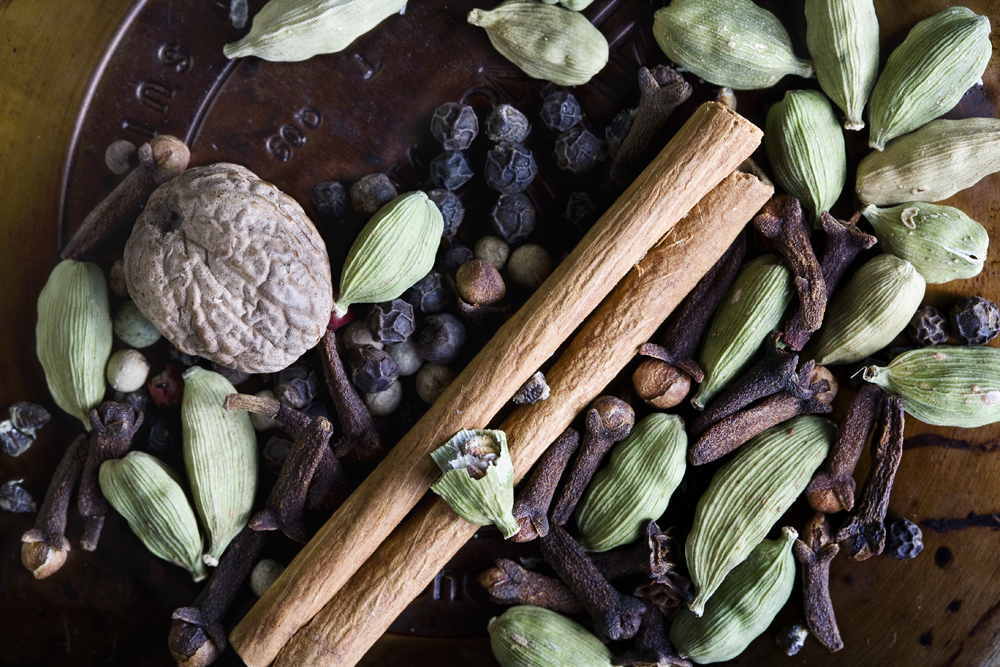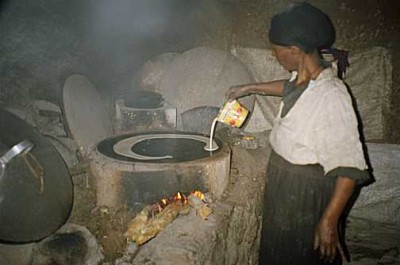|
Mitmita
''Mitmita'' ( am, ሚጥሚጣ, ) is a powdered seasoning mix used in Ethiopia. It is orange-red in color and contains ground African bird's eye chili peppers, Ethiopian cardamom (korerima), cloves, and salt.Mesfin, D.J. ''Exotic Ethiopian Cooking'' (2006): 20. Falls Church, VA: Ethiopian Cookbooks Enterprises It occasionally has other spices including cinnamon, cumin, and ginger. The mixture is used to season the raw beef dish ''kitfo'' and may also be sprinkled on ''ful medames'' (fava beans). In addition, ''mitmita'' may be presented as a condiment and sprinkled on other delicacies or spooned onto a piece of ''injera'', so that morsels may be lightly dipped into it. See also * Berbere Berbere ( Oromo: ''Barbaree'', am, በርበሬ ''bärbäre'', ti, በርበረ ''bärbärä'') is a spice mixture whose constituent elements usually include chili peppers, coriander, garlic, ginger, Ethiopian holy basil (besobela) seeds, ''kora ..., another Ethiopian spice mixture Referen ... [...More Info...] [...Related Items...] OR: [Wikipedia] [Google] [Baidu] |
Seasoning Mix
Spice mixes are blended spices or herbs. When a certain combination of herbs or spices is called for in a recipe, it is convenient to blend these ingredients beforehand. Blends such as chili powder, curry powder, herbes de Provence, garlic salt, and other seasoned salts are traditionally sold pre-made by grocers, and sometimes baking blends such as pumpkin pie spice are also available. These spice mixes are also easily made by the home cook for later use. Masala Masala (from Hindi/Urdu ''masalah'', based on Arabic ''masalih''). is a term from the Indian subcontinent for a spice mix. A masala can be either a combination of dried (and usually dry-roasted) spices, or a paste (such as vindaloo masala) made from a mixture of spices and other ingredients—often garlic, ginger, onions, chilli paste and tomato. Masalas are used extensively in Indian cuisine to add spice and flavour, most familiarly to Western cuisine in chicken tikka masala and chicken curry, or in masala chai. Other ... [...More Info...] [...Related Items...] OR: [Wikipedia] [Google] [Baidu] |
Aframomum Corrorima
''Aframomum corrorima'' is a species of flowering plant in the ginger family, Zingiberaceae. It's a herbaceous perennial that produces leafy stems 1–2 meters tall from rhizomatous roots. The alternately-arranged leaves are dark green, 10–30 cm long and 2.5–6 cm across, elliptical to oblong in shape. Pink flowers are borne near the ground and give way to red, fleshy fruits containing shiny brown seeds, which are typically 3–5 mm in diameter. The spice, known as Ethiopian cardamom, false cardamom, or ''korarima'', is obtained from the plant's seeds (usually dried), and is extensively used in Ethiopian and Eritrean cuisine. It is an ingredient in ''berbere'', ''mitmita'', ''awaze'', and other spice mixtures, and is also used to flavor coffee. Its flavor is comparable to that of the closely related ''Elettaria cardamomum'' or green cardamom. In Ethiopian herbal medicine, the seeds are used as a tonic, carminative, and laxative. The plant is native to Tanzania ... [...More Info...] [...Related Items...] OR: [Wikipedia] [Google] [Baidu] |
Kitfo
''Kitfo'' ( am, ክትፎ, ), is an Ethiopian traditional dish which originated among the Gurage people. It consists of minced raw beef, marinated in ''mitmita'' (a chili powder-based spice blend) and ''niter kibbeh'' (a clarified butter infused with herbs and spices). The word comes from the Ethio-Semitic root k-t-f, meaning "to chop finely; mince." ''Kitfo'' cooked lightly rare is known as ''kitfo leb leb''.Mesfin, D.J. ''Exotic Ethiopian Cooking'', Falls Church, Virginia: Ethiopian Cookbooks Enterprises, 2006, pp.124, 129. ''Kitfo'' is often served alongside—sometimes mixed with—a mild cheese called ''ayibe'' or cooked greens known as ''gomen''. In many parts of Ethiopia, ''kitfo'' is served with ''injera'', a spongy, absorbent sourdough crepe-style bread made from fermented teff flour, although in traditional Gurage cuisine, one would use '' kocho'', a thick flatbread made from the ''ensete'' plant. An ''ensete'' leaf may be used as a garnish. Though not considere ... [...More Info...] [...Related Items...] OR: [Wikipedia] [Google] [Baidu] |
Berbere
Berbere ( Oromo: ''Barbaree'', am, በርበሬ ''bärbäre'', ti, በርበረ ''bärbärä'') is a spice mixture whose constituent elements usually include chili peppers, coriander, garlic, ginger, Ethiopian holy basil (besobela) seeds, ''korarima'', rue, ajwain or radhuni, nigella, and fenugreek.Debrawork Abate (1995 EC) 993 EC የባህላዌ መግቦች አዘገጃጀት raditional Food Preparation(in Amharic) (2nd ed.). Addis Ababa: Mega Asatame Derjet (Mega Publisher Enterprise). pp. 22–23. It is a key ingredient in the cuisines of Ethiopia and Eritrea. Berbere also refers to chili pepper itself. Berbere sometimes encompasses herbs and spices that are less well known internationally. These include both cultivated plants and those that grow wild in Ethiopia, such as korarima (''Aframomum corrorima''). See also * Mitmita, another Ethiopian spice mixture * Piri piri * List of Ethiopian dishes and foods This is a list of Ethiopian and Eritrean dishes and ... [...More Info...] [...Related Items...] OR: [Wikipedia] [Google] [Baidu] |
Ethiopian Cuisine
Ethiopian cuisine ( am, የኢትዮጵያ ምግብ "Ye-Ītyōṗṗyā məgəb") characteristically consists of vegetable and often very spicy meat dishes. This is usually in the form of ''wat,'' a thick stew, served on top of ''injera'' ( am, እንጀራ), a large sourdough flatbread,Javins, Marie"Eating and Drinking in Ethiopia." Accessed July 2011. which is about in diameter and made out of flour. eat most of the time with their right hands, using piece ... [...More Info...] [...Related Items...] OR: [Wikipedia] [Google] [Baidu] |
Ethiopia
Ethiopia, , om, Itiyoophiyaa, so, Itoobiya, ti, ኢትዮጵያ, Ítiyop'iya, aa, Itiyoppiya officially the Federal Democratic Republic of Ethiopia, is a landlocked country in the Horn of Africa. It shares borders with Eritrea to the north, Djibouti to the northeast, Somalia to the east and northeast, Kenya to the south, South Sudan to the west, and Sudan to the northwest. Ethiopia has a total area of . As of 2022, it is home to around 113.5 million inhabitants, making it the 13th-most populous country in the world and the 2nd-most populous in Africa after Nigeria. The national capital and largest city, Addis Ababa, lies several kilometres west of the East African Rift that splits the country into the African and Somali tectonic plates. Anatomically modern humans emerged from modern-day Ethiopia and set out to the Near East and elsewhere in the Middle Paleolithic period. Southwestern Ethiopia has been proposed as a possible homeland of the Afroasiatic langua ... [...More Info...] [...Related Items...] OR: [Wikipedia] [Google] [Baidu] |
Injera
Injera (, ; om, Biddeena; ) is a sour fermented pancake-like flatbread with a slightly spongy texture, traditionally made of teff flour. In Ethiopia, Eritrea, and some parts of Sudan, injera is the staple. Injera is central to the dining process, like bread or rice elsewhere. Ingredients Traditionally, injera is made with just two ingredients – teff flour and water. Teff flour is ground from the grains of ''Eragrostis tef'', also known as teff, an ancient cereal crop from the Ethiopian Highlands. Teff production is limited to certain middle elevations with adequate rainfall, and, as it is a low-yield crop, it is relatively expensive for the average farming household. As many farmers in the Ethiopian highlands grow their own subsistence grains, wheat, barley, corn, or rice flour are sometimes used to replace some or all of the teff content. Teff seeds are graded according to color, used to make different kinds of injera: ''nech'' (white), ''key'' or ''quey'' (red), and '' ... [...More Info...] [...Related Items...] OR: [Wikipedia] [Google] [Baidu] |
Fava Bean
''Vicia faba'', commonly known as the broad bean, fava bean, or faba bean, is a species of vetch, a flowering plant in the pea and bean family Fabaceae. It is widely cultivated as a crop for human consumption, and also as a cover crop. Varieties with smaller, harder seeds that are fed to horses or other animals are called field bean, tic bean or tick bean. Horse bean, ''Vicia faba'' var. ''equina'' Pers., is a variety recognized as an accepted name. This legume is very common in Southern European, Northern European, East Asian, Latin American and North African cuisines. Some people suffer from favism, a hemolytic response to the consumption of broad beans, a condition linked to a metabolism disorder known as G6PDD. Otherwise the beans, with the outer seed coat removed, can be eaten raw or cooked. In young plants, the outer seed coat can be eaten, and in very young plants, the seed pod can be eaten. Description ''Vicia faba'' is a stiffly erect, annual plant tall, with two ... [...More Info...] [...Related Items...] OR: [Wikipedia] [Google] [Baidu] |
Ful Medames
Ful medames ( ar, فول مدمس, ' ; other spellings include ''ful mudammas'' and '' foule mudammes''), or simply fūl, is a stew of cooked fava beans served with olive oil, cumin, and optionally with chopped parsley, garlic, onion, lemon juice, chili pepper, and other vegetable, herb, and spice ingredients. Ful medames is traditionally made in and served out of a large metal jug. It is notably a staple food in Egypt and is considered a national dish, especially in the northern cities of Cairo and Gizah. Fava beans can sometimes be also found in other cuisines in the Middle East, and Africa, though cooked differently. History Some writers have suggested that ful medames dated all the way back to Ancient Egypt. Some evidence of the use of ful is a cache of 2,600 dried fava beans unearthed at a late Neolithic site on the outskirts of Nazareth. This dish is mentioned in the Jerusalem Talmud, indicating that it was used in Horn of African and Middle Eastern countries since t ... [...More Info...] [...Related Items...] OR: [Wikipedia] [Google] [Baidu] |
Cinnamon
Cinnamon is a spice obtained from the inner bark of several tree species from the genus ''Cinnamomum''. Cinnamon is used mainly as an aromatic condiment and flavouring additive in a wide variety of cuisines, sweet and savoury dishes, breakfast cereals, snack foods, bagels, teas, and traditional foods. The aroma and flavour of cinnamon derive from its essential oil and principal component, cinnamaldehyde, as well as numerous other constituents including eugenol. Cinnamon is the name for several species of trees and the commercial spice products that some of them produce. All are members of the genus ''Cinnamomum'' in the family Lauraceae. Only a few ''Cinnamomum'' species are grown commercially for spice. ''Cinnamomum verum'' (AKA ''C. zeylanicum''), known as "Ceylon cinnamon" after its origins in Sri Lanka (formerly Ceylon), is considered to be "true cinnamon", but most cinnamon in international commerce is derived from four other species, usually and more correctly refe ... [...More Info...] [...Related Items...] OR: [Wikipedia] [Google] [Baidu] |
Ginger
Ginger (''Zingiber officinale'') is a flowering plant whose rhizome, ginger root or ginger, is widely used as a spice A spice is a seed, fruit, root, bark, or other plant substance primarily used for flavoring or coloring food. Spices are distinguished from herbs, which are the leaves, flowers, or stems of plants used for flavoring or as a garnish. Spice ... and a folk medicine. It is a herbaceous perennial plant, perennial which grows annual pseudostems (false stems made of the rolled bases of leaves) about one meter tall bearing narrow leaf blades. The inflorescences bear flowers having pale yellow petals with purple edges, and arise directly from the rhizome on separate shoots. Ginger is in the family (taxonomy), family Zingiberaceae, which also includes turmeric (''Curcuma longa''), cardamom (''Elettaria cardamomum''), and galangal. Ginger originated in Maritime Southeast Asia and was likely domesticated first by the Austronesian peoples. It was transported with ... [...More Info...] [...Related Items...] OR: [Wikipedia] [Google] [Baidu] |
Cumin
Cumin ( or , or Article title ) (''Cuminum cyminum'') is a in the , native to the . Its seeds – each one contained within a fruit, which is dried – are used in the |



.jpg)



